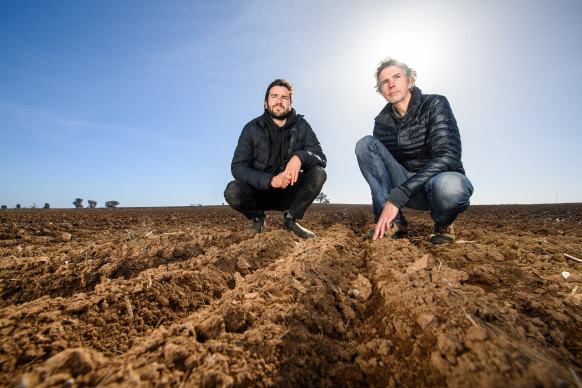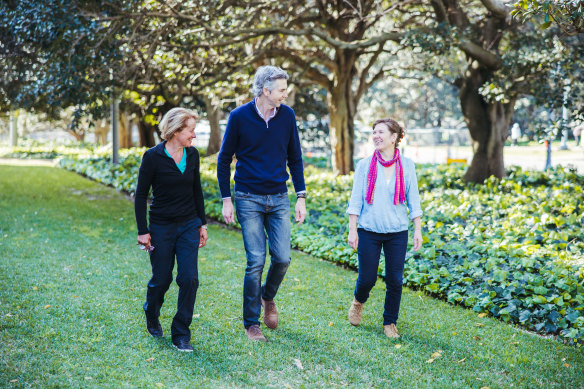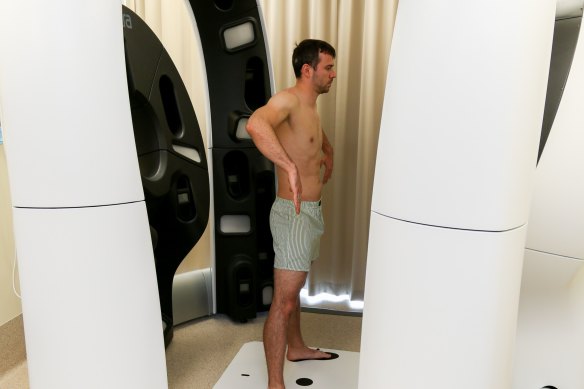By Liam Mannix
Professor Peter Banks is trying his hardest to see with his nose.
This is, as you can imagine, quite difficult for humans. Not so for animals. Many rely not on vision, but scent – of predator and prey, of home and of mate – to map their worlds.

PhD student Finn Parker and conservation biologist Professor Peter Banks at the site of their trial.Credit:
When farmers see mice or bugs eating their crops, they pull out toxins that kill the hungry animals – and poison the land.
Banks, a conservation scientist at the University of Sydney, has a better solution: he’s started meddling with how crops smell.
What if a mouse couldn’t smell the wheatgerm it feeds on? What if a feral cat couldn’t smell the native bird it hunted?
It seems whimsical, but over the past two decades, Banks and his team have shown that it works.

Clare McArthur, Peter Banks and Catherine Price are finalists in the Eureka Awards for environmental research.Credit: Dion Georgopoulos
They have cut mice damage to wheat by 73 per cent without killing a single animal or using a drop of poison. And scent trickery deployed to protect threatened native birds doubled the number of young fledgings born.
On Wednesday, the team’s work won the prize for environmental research at the Australian Museum Eureka Prizes in Sydney, the nation’s top science awards. The team, and 18 others, will share $180,000 in prize money.
The tricks are based on a fundamental property of predators: they are lazy. If a scent trail does not lead to food, they quickly learn to ignore the scent.
House mice, Banks discovered, may have evolved to take advantage. They deliberately dump scent droplets everywhere they go; confused predators soon give up.
Why couldn’t farmers do the same, thought Banks. “There was, quite literally, a Eureka moment,” he said.
Banks remembers looking at pictures of freshly sown fields after they had been attacked by mice.
The mice did not need to furrow around for the seeds they were after: they dug a single hole in exactly the right spot. A hallmark of a scent predator.
In the 2021 mouse plague, the team sprayed fields of wheat with wheatgerm – the very scent the mice were hunting. The confused mice dug holes in all the wrong spots, until they gave up.
“You can’t smell a wheat seed if the background smells like wheat,” Banks said with a laugh.
In 2016, the team flew to New Zealand, where banded dotterels and oystercatchers are under critical threat from ferrets, cats and hedgehogs.
Banks’ team extracted bird scent and mixed it with Vaseline, before daubing it randomly across the landscape.
The predators followed the scent and found nothing. Eventually, they stopped coming, Banks said.
“And by the time the birds arrived to breed, they weren’t as interested in pursuing those smells,” he said.
Banks’ scent magic is already being rolled out on farms. “Nothing gets harmed, gets killed, and we still solve the problems that animals are causing,” he said. “You can’t poison your way out of a mouse plague.”
The Eureka Prize for Excellence in Interdisciplinary Scientific Research went to a team that is coding AI that will crawl across body scans and check each spot for signs of melanoma.
Quietly, a network of 15 3D camera rigs have been installed across Australia.
When they go live, Professor H. Peter Soyer is hopeful they will herald a “paradigm shift in the way melanoma is managed”.
Each rig has 92 cameras and can generate a 3D map of your body with photographs of each millimetre of your skin.

A patient standing inside one of the 3D camera rigs.
“You don’t have to move,” said Soyer, who heads the Australian Centre of Excellence in Melanoma Imaging and Diagnosis. “The only thing you have to do is close your eyes.”
Eventually, Soyer and the team hope the scanners will form the backbone of a national melanoma screening program.
“The beauty of this system is imagine we image this person six months later. The AI will then show if a pigmented spot has grown or not, which is a sign of cancer,” Soyer said.
The Examine newsletter explains and analyses science with a rigorous focus on the evidence. Sign up to get it each week.